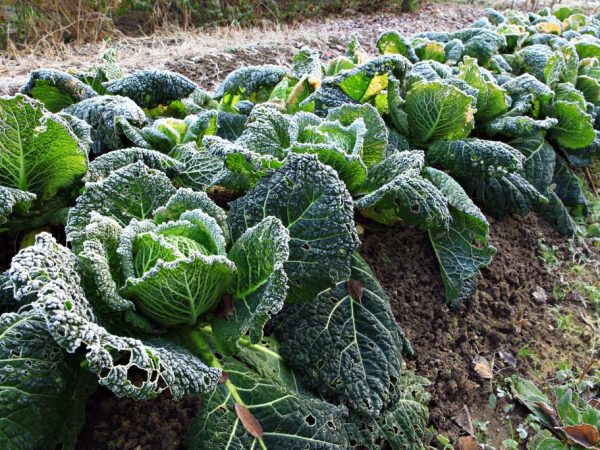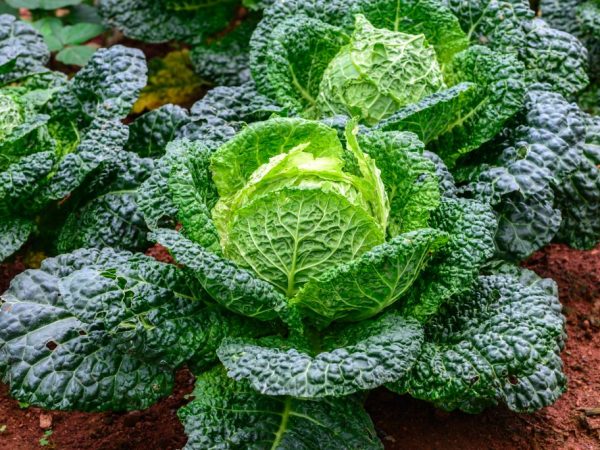Characteristics of Savoy cabbage
Vegetables are an essential component of the human diet. Recently, products that are unusual for domestic gourmets have been increasingly seen on the table. What is Savoy cabbage and how to grow it properly? We will analyze the basics of agricultural technology and talk about the benefits and dangers of culture.

Characteristics of Savoy cabbage
Description of the plant
The vegetable is named after the Italian city of Savoy, from where it came to Eastern Europe in the 19th century. The refined taste and delicate texture appealed to gourmets. Increasingly, the culture can be found in the beds next to an ordinary white calf.
Characteristics
Savoy cabbage looks different from the usual garden varieties. According to the description, these are beautiful, rounded heads of cabbage without any curvature or abnormal elongation. The leaves are very curly, thin and corrugated throughout the blade.
The taste is similar to that of white cabbage, but the aroma is not so sharp and intense. Delicate vegetables without thick veins are suitable for all dishes. They soften quickly, so you don't need to heat them for a long time. In salads, the vegetable crunches pleasantly, does not taste bitter.
Varieties
Thanks to unique breeding methods, Savoy cabbage varieties can be found both in the southern regions and in Siberia and beyond the Urals. Plants differ in cultivation characteristics and ripening times.
Savoy cabbage varieties:
- Moscow lacemaker. An early vegetable that is ready for use in food 110 days after emergence from seeds. The products are tender, reaching 1.5 kg in ripe condition.
- Gold early. Excellent Savoy cabbage forms a harvest 105 days after sprouting. Light yellow leaves do not crack, they have a great taste.
- Petrovna. Another early maturing plant, ready for use 3.5 months after emerging from the ground. Delicate plates are used both in salads and for heat treatment.
- Twirl 1340. In a medium late variety, taste characteristics appear two months after the heads of cabbage are cut. Loose, large heads grow up to 2 kg.
- Winter delicacy. The powerful late variety is ready for consumption after 150 days. Huge corrugated leaves of rich green color with a red tint. Retains commercial qualities for three months.
- Uralochka. The best variety for fresh consumption. A large head of cabbage is resistant to cracking. The products are removed 100 days after planting the seedlings in the ground.
Strengths of culture
Consider how savoy cabbage is good for the human body?
Important components
The culture contains many substances necessary for metabolic processes. Potassium, magnesium and sodium are responsible for healthy heart function. With regular use of the fresh product, you can forget about the problems of the cardiovascular system.The combination of phosphorus, calcium and iron contributes to the proper building of bone mass and the maintenance of normal hemoglobin levels. Tasty leaves contain a lot of vitamins:
- group B (1, 2 and 6);
- AND;
- FROM;
- E;
- PP.
The beneficial properties of savoy cabbage allow it to be used as an adjuvant in the treatment of vitamin deficiencies.
Diet food
Like all cabbage, the Savoyard variety is low in calories. In 100 gr. fresh product is only 28 kcal, and after steaming - no more than 24 kcal. If the leaves are extinguished with the use of fats, then the energy value increases by 3 times.
Low-calorie cabbage, low in carbohydrates and sugar, is a good option for those who are looking for weight. In addition, there is a lot of fiber in the composition. The substance removes toxins from the digestive system, which improves metabolic processes and promotes rapid weight loss.

Cabbage is recommended for people with stomach problems
After heat treatment, the product is easily digestible. This feature is useful for gastritis and ulcers. After a complete examination of the body, doctors prescribe a dietary meal using the leaves. In addition, in a pureed state, the vegetable is indicated for small children (after 7 months) and the elderly. The plant does not harm people with diabetes.
Prevention and treatment
Savoy cabbage benefits from its ability to remove excess fluid from the body. This lowers blood pressure.
It is recommended to use such cabbage for anemia, neurasthenia, as well as for strengthening nails and hair. By the way, when treating anemia, doctors advise replacing ordinary white-headed varieties with a more tender Savoyard.
The vegetable contains glutathione, which improves skin elasticity. Fresh juice and crushed leaves are used in anti-aging masks. In addition, the culture regenerates tissues and nerve endings, which is used in the treatment of injuries and burns.
The high content of ascorbigen protects the body from cancer. The substance blocks dangerous tumors at an early stage and prevents them from developing.
Contraindications
Despite the abundance of useful properties, Savoy cabbage is not an absolute panacea. There is no cure with diet alone. There are a number of caveats to keep in mind.
- Pancreatitis In case of illness, fresh cabbage is prohibited, and after heat treatment, no more than 100 g per day is allowed. Fiber and active substances negatively affect the pancreas, causing an exacerbation of the disease.
- Thyroid gland. The plant flushes iodine out of the body.
- After operations on the stomach, intestines. Regeneration is very slow, and the product irritates the mucous membrane.
- Children under 7 months should not be given a vegetable in any form. The first complementary foods begin after they have tasted the zucchini and potatoes without any problems.
In addition to the above, savoy cabbage can sometimes be allergic. Individual intolerance is rare, but it exists. Still do not accept products that were grown in violation of breeding rules.
Growing
To get a bountiful harvest of a tasty vegetable, you need to know all the intricacies of agricultural technology. The cultivation of the plant is almost the same as the usual garden variety. There are a number of rules to consider when growing.
Preparatory procedures
The place for vegetables must be prepared in the fall. Cabbage prefers to grow in nutritious, alkaline soil with plenty of sun. The soil for the winter is dug up with fertilizers, if necessary, liming is carried out. Remember that it is forbidden to plant a crop after:
- beets;
- tomatoes;
- cabbage.
In the spring, the earth is re-dug up with dressings. Each square requires 500 g of ash with sand and 80 g of superphosphate. A month before planting seedlings from fungi, the site is treated with a solution of Bordeaux liquid or 3% copper sulfate.
Before sowing, the seeds are carefully sorted out, leaving the grains larger than 1.5 mm. First, the raw material is quenched: for 15 minutes, it is placed in a container with hot water (up to 50 C), after which it is lowered into cold water for 2 minutes. The day before planting, they are soaked for a couple of hours in Fitosporin solution and in Epin. The seed is left to dry on a napkin overnight.
Sowing

Cabbage needs good care
Savoy cabbage is planted in two ways - by seedling and directly into open ground. The first type is suitable for the Middle Lane and northern regions. For areas with warm climates and long summers, you can choose the second option.
Growing for seedlings takes an average of 30-45 days. You can start agricultural work in early March and April. To do this, the container is filled with nutritious, loose earth, watered abundantly with water. In the soil, holes are made up to 1.5 cm deep, in which three seeds are placed.
In order for the plants to hatch, it is necessary to keep the crops in a warm (at least 20 ° C), shaded place. As soon as the seedlings have appeared, the container is rearranged in the sun, and the temperature is reduced to 15 ° C during the day and 11 ° C at night. Growing in the cold does not allow the bushes to stretch out.
After 4 adult leaves appear, you can start diving. Gently spoon the plants out of the ground with a spoon, trying not to damage the roots. The bushes are transplanted into separate pots, preferably from peat. The culture stops growing tops and starts developing the lower parts.
Landing in the ground
A week before agricultural work, a hardening procedure is carried out - gradually they accustom the young to the natural sun and low temperature. So that the seedlings do not die from fungi, it is better to carry out preventive watering with the drug Maxim summer resident. After the threat of frost has passed, you can begin to transfer the seedlings to a permanent place of growth. The most suitable time for disembarkation is the second half of May and early June.
Dig holes at a distance of at least 30 cm from each other. The depth of the holes should be greater than the height of the pot. A nutritious pillow of wood ash and humus is placed on the bottom. An hour before the start of work, all the holes are watered, after which you can start planting.
How to care
Like the white-headed varieties, the Italian is not a very capricious plant. Caring for Savoy cabbage consists in weeding the beds regularly, hilling and watering. To facilitate work, it is recommended to immediately mulch the soil at the roots with sawdust and peat.
The culture loves moisture very much, therefore it is irrigated every 3 days, and in case of heat - once a day. The procedures are best done in the morning or in the evening, otherwise sun drops on the foliage will cause burns. During the growing season, three stages of feeding are needed.
- 10 days after germination. Earlier applications will not be beneficial, but will be harmful to immature plant roots. For the first procedures, you can choose to sprinkle with mineral fertilizers on the sheet. Half the recommended dose is diluted in 1000 ml of liquid.
- Two weeks after planting in open ground. The nutrient cushion has already exhausted its resource, and the voracious Savoy cabbage requires new applications.
- During the formation of the heads. The plant needs strength to set the crop, so we recommend fertilizing with potassium preparations under the root and along the leaf.
Collection and storage
Cabbage matures on average within 100-120 days. You need to remove products in the same way as white-headed species. The heads are carefully cut off with a knife, leaving several covering leaves on them.
Storing Savoy cabbage is permitted in the vegetable section of the refrigerator. Early varieties are best consumed immediately - they quickly lose marketability. Medium and late ones are great in the cold for 2 or 3 months. Sometimes the crop can be frozen, but in the dish it will acquire a specific flavor.
It is worth remembering that the cut heads lose keeping quality, so we recommend that you immediately eat the plant. Storage of such specimens should take place with a film, otherwise the foliage will lose moisture. Dehydrated products do not crunch and quickly lose their taste.
Conclusion
Savoy cabbage is a delicious vegetable that has gone far beyond cooking. Knowing how to plant and care for a plant, you can grow a bountiful harvest without any problems with minimal physical costs.

